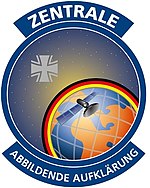Central imaging education
|
Central imaging education |
|
|---|---|
 Internal association badge |
|
| Lineup | January 1, 2013 |
| Country |
|
| Armed forces |
|
| Military organizational area |
|
| Branch of service | Telecommunication troops EloKa |
| Strength | 160 |
| Insinuation |
|
| Location |
Philipp-Freiherr-von-Boeselager barracks |
| Web presence | ZAbb Aufkl |
| Head of Department | |
| ladder | Colonel Dirk Gleinig |
The central imaging reconnaissance ( ZAbb Aufkl ) is a military service of the Bundeswehr in the organizational area of cyber and information space , which is directly subordinate to the strategic reconnaissance command and with which it shares a property , the Philipp-Freiherr-von-Boeselager barracks in Grafschaft - Gelsdorf ( Rhineland-Palatinate ). Major parts of the Bundeswehr's satellite image acquisition and analysis are concentrated in the headquarters.
Tasks and way of working
The task of the Central Image Reconnaissance is the military reconnaissance . It gains satellite images from military systems, operates the national radar satellite system SAR-Lupe and cooperates internationally with partners. It evaluates satellite images, provides products for the appropriate management levels and supports measures in the context of national risk and crisis management, crisis support operations and the arms control treaty " Open Skies " by evaluating aerial and satellite images and processing data.
In the center, satellite images of different systems and sensors (radar, electro-optical, infrared, multispectral) are processed, evaluated and demand-oriented products are created from them - partly in correlation with other sources. As part of a bilateral agreement with France, it is possible to use satellite images from the Helios II electro-optical reconnaissance system.
The head office works for cross-departmental crisis prevention. Its mission, crisis support teams (KUT) and inserts the army by capturing, verification and elaboration of relevant for crisis prevention data to support and adjust the results in an information system (KVInfoSys) that these as a basis in the case of an evacuation operation are available . For this purpose, a large number of different objects are identified and identified using appropriate image products such as city overviews, detailed plans of critical infrastructure , e.g. B. airports and evacuation routes prepared and made available for the preparation and implementation of possible evacuation operations.
As part of the open sky contract, the head office is tasked with digitizing and evaluating the image material flown and making the results available to the Bundeswehr Verification Center (ZVBw). Sensors of the electromagnetic spectrum are used for photo, radar and, since 2006, infrared recordings. Digital sensors have also been used since 2014, with which significantly better observation results can be achieved.
history
The head office was created on January 1, 2013, when the “Imaging Reconnaissance and Object Processing” department was outsourced from the Strategic Reconnaissance Command. Since July 1, 2017, it has been part of the cyber and information space organizational area. Colonel Dirk Gleinig has been head of the headquarters since January 8, 2018.
structure
The center is divided into four analytical departments structured, have the world's jurisdictional.
coat of arms
The coat of arms is round to represent the dimension of space and the worldwide area of responsibility in the form of the globe. The integration of the satellite represents the sensor used. The iron cross symbolizes the affiliation of the agency to the armed forces and the colors black-red-gold as a horizon around the globe symbolize the Federal Republic of Germany as a consumer for worldwide information supply. The color scheme is based on the darkness of space. The badge is framed by the name of the department in writing.
Individual evidence
- ^ Bundeswehr location database. In: Center for Military History and Social Sciences of the Bundeswehr . Retrieved October 16, 2019 .
- ↑ Answer of the Federal Government to the minor question from MPs Sevim Dağdelen, Christine Buchholz, Annette Groth, other MPs and the DIE LINKE parliamentary group. - Printed matter 18/11688 - Structures of the organizational area of cyber and information space of the Bundeswehr in North Rhine-Westphalia (printed matter 18/12277). In: German Bundestag . May 9, 2017, accessed October 16, 2019 .
- ↑ Curriculum vitae Head of the ZAbb Aufkl Colonel Dirk Gleinig. In: Bundeswehr. Retrieved February 23, 2020 .
Coordinates: 50 ° 34 ′ 6 ″ N , 7 ° 2 ′ 10 ″ E